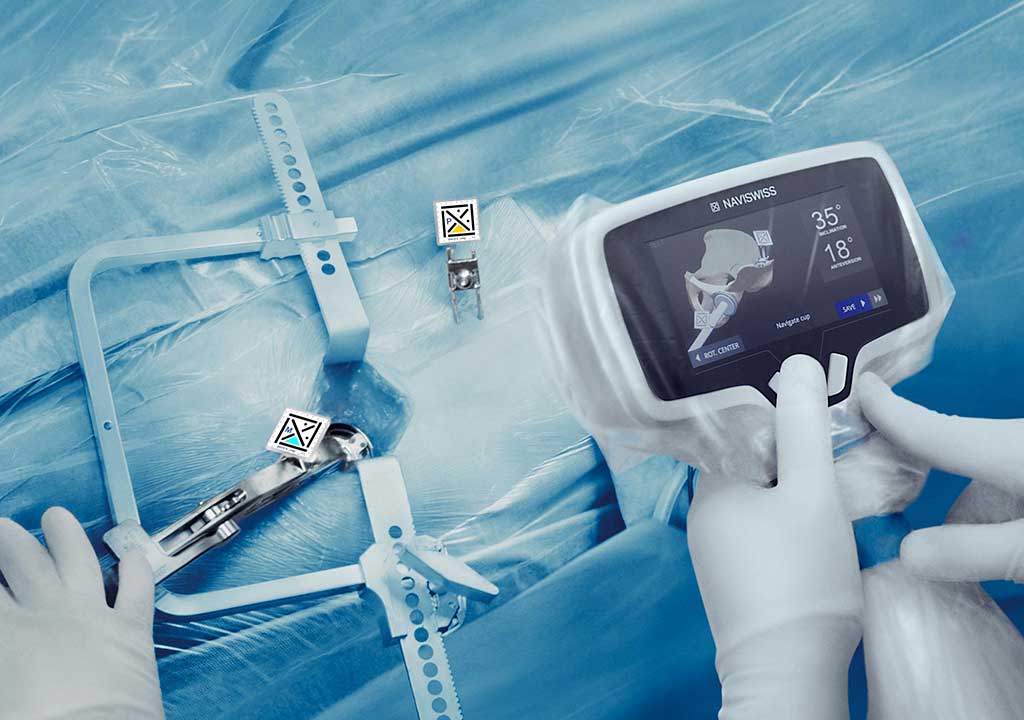Imageless Navigation System Assists Hip Replacement Surgery 
|
By HospiMedica International staff writers Posted on 08 Oct 2020 |

Image: M and P NAVItag trackers in position (Photo courtesy of Naviswiss)
A hand-held total hip replacement (THR) navigation system reduces overall radiation exposure by utilizing imageless technology.
The Naviswiss (Brugg, Switzerland) Naviswiss miniature hip navigation system uses proprietary optical tracking technology to provide real-time intra-operative measurements (down to the degree) to accurately determine anteversion, inclination, leg length, and offset. When needed, ultra-lightweight NAVItag trackers are attached to reference the anatomy. The P-tag is fixed to the pelvis with two 3 mm pins via small stab incisions; it serves as fixpoint for cup navigation. The M-tag is seated on the cup impactor. And the F-tag is attached to the femur via a single pin; it is used for leg length and offset navigation.
Relationships between the tags are documented using the camera. Cup inclination and anteversion are displayed in real-time during alignment and insertion. When reducing the joint, the navigation assists in adjusting leg length and offset. Final implantation parameters are documented in a detailed surgical report. The open platform system works with all major hip implants and surgical approaches, as does the magnetic attachment of the NAVItag, which adheres to the cup impactor. The Naviswiss system is portable, and can be easily transported between operating rooms, supporting multiple procedures.
“At Naviswiss we strive to make hip navigation smarter by putting it in the hands of the orthopedic surgeon. Based on our patented Swiss technology, the Naviswiss system guides the surgeon through three easy steps,” said Jan Stifter, CEO of Naviswiss. “The relevant results are provided with digital precision and are used to precisely position the implant and to document the outcome. We are convinced that our system helps improve the quality of surgery to benefit the patient and health care system.”
A hip replacement implant is a ball-and-socket mechanism, designed to simulate a human hip joint and mimic its movement. Typical components include a stem that inserts into the femur, a ball that replaces the head of the thigh bone, and a shell that lines the hip socket. Assessment of individual patient pelvic tilt and digital measurement of leg length and offset changes are used to achieve more consistent leg length restoration.
Related Links:
Naviswiss
The Naviswiss (Brugg, Switzerland) Naviswiss miniature hip navigation system uses proprietary optical tracking technology to provide real-time intra-operative measurements (down to the degree) to accurately determine anteversion, inclination, leg length, and offset. When needed, ultra-lightweight NAVItag trackers are attached to reference the anatomy. The P-tag is fixed to the pelvis with two 3 mm pins via small stab incisions; it serves as fixpoint for cup navigation. The M-tag is seated on the cup impactor. And the F-tag is attached to the femur via a single pin; it is used for leg length and offset navigation.
Relationships between the tags are documented using the camera. Cup inclination and anteversion are displayed in real-time during alignment and insertion. When reducing the joint, the navigation assists in adjusting leg length and offset. Final implantation parameters are documented in a detailed surgical report. The open platform system works with all major hip implants and surgical approaches, as does the magnetic attachment of the NAVItag, which adheres to the cup impactor. The Naviswiss system is portable, and can be easily transported between operating rooms, supporting multiple procedures.
“At Naviswiss we strive to make hip navigation smarter by putting it in the hands of the orthopedic surgeon. Based on our patented Swiss technology, the Naviswiss system guides the surgeon through three easy steps,” said Jan Stifter, CEO of Naviswiss. “The relevant results are provided with digital precision and are used to precisely position the implant and to document the outcome. We are convinced that our system helps improve the quality of surgery to benefit the patient and health care system.”
A hip replacement implant is a ball-and-socket mechanism, designed to simulate a human hip joint and mimic its movement. Typical components include a stem that inserts into the femur, a ball that replaces the head of the thigh bone, and a shell that lines the hip socket. Assessment of individual patient pelvic tilt and digital measurement of leg length and offset changes are used to achieve more consistent leg length restoration.
Related Links:
Naviswiss
Latest Surgical Techniques News
- Minimally Invasive Endoscopic Surgery Improves Severe Stroke Outcomes
- Novel Glue Prevents Complications After Breast Cancer Surgery
- Breakthrough Brain Implant Enables Safer and More Precise Drug Delivery
- Bioadhesive Sponge Stops Uncontrolled Internal Bleeding During Surgery
- Revolutionary Nano Bone Material to Accelerate Surgery and Healing
- Superior Orthopedic Implants Combat Infections and Quicken Healing After Surgery
- Laser-Based Technique Eliminates Pancreatic Tumors While Protecting Healthy Tissue
- Surgical Treatment of Severe Carotid Artery Stenosis Benefits Blood-Brain Barrier
- Revolutionary Reusable Duodenoscope Introduces 68-Minute Sterilization
- World's First Transcatheter Smart Implant Monitors and Treats Congestion in Heart Failure
- Hybrid Endoscope Marks Breakthrough in Surgical Visualization
- Robot-Assisted Bronchoscope Diagnoses Tiniest and Hardest to Reach Lung Tumors
- Diamond-Titanium Device Paves Way for Smart Implants that Warn of Disease Progression
- 3D Printable Bio-Active Glass Could Serve as Bone Replacement Material
- Spider-Inspired Magnetic Soft Robots to Perform Minimally Invasive GI Tract Procedures
- Micro Imaging Device Paired with Endoscope Spots Cancers at Earlier Stage
Channels
Critical Care
view channel
AI Heart Attack Risk Assessment Tool Outperforms Existing Methods
For decades, doctors have relied on standardized scoring systems to assess patients with the most common type of heart attack—non-ST-elevation acute coronary syndrome (NSTE-ACS). The GRACE score, used... Read more
'Universal' Kidney to Match Any Blood Type
Blood-type incompatibility has long been one of the greatest obstacles in organ transplantation, forcing thousands of patients—particularly those with type O blood—to wait years longer for compatible donors.... Read morePatient Care
view channel
Revolutionary Automatic IV-Line Flushing Device to Enhance Infusion Care
More than 80% of in-hospital patients receive intravenous (IV) therapy. Every dose of IV medicine delivered in a small volume (<250 mL) infusion bag should be followed by subsequent flushing to ensure... Read more
VR Training Tool Combats Contamination of Portable Medical Equipment
Healthcare-associated infections (HAIs) impact one in every 31 patients, cause nearly 100,000 deaths each year, and cost USD 28.4 billion in direct medical expenses. Notably, up to 75% of these infections... Read more
Portable Biosensor Platform to Reduce Hospital-Acquired Infections
Approximately 4 million patients in the European Union acquire healthcare-associated infections (HAIs) or nosocomial infections each year, with around 37,000 deaths directly resulting from these infections,... Read moreFirst-Of-Its-Kind Portable Germicidal Light Technology Disinfects High-Touch Clinical Surfaces in Seconds
Reducing healthcare-acquired infections (HAIs) remains a pressing issue within global healthcare systems. In the United States alone, 1.7 million patients contract HAIs annually, leading to approximately... Read moreHealth IT
view channel
Printable Molecule-Selective Nanoparticles Enable Mass Production of Wearable Biosensors
The future of medicine is likely to focus on the personalization of healthcare—understanding exactly what an individual requires and delivering the appropriate combination of nutrients, metabolites, and... Read moreBusiness
view channel
Philips and Masimo Partner to Advance Patient Monitoring Measurement Technologies
Royal Philips (Amsterdam, Netherlands) and Masimo (Irvine, California, USA) have renewed their multi-year strategic collaboration, combining Philips’ expertise in patient monitoring with Masimo’s noninvasive... Read more
B. Braun Acquires Digital Microsurgery Company True Digital Surgery
The high-end microsurgery market in neurosurgery, spine, and ENT is undergoing a significant transformation. Traditional analog microscopes are giving way to digital exoscopes, which provide improved visualization,... Read more
CMEF 2025 to Promote Holistic and High-Quality Development of Medical and Health Industry
The 92nd China International Medical Equipment Fair (CMEF 2025) Autumn Exhibition is scheduled to be held from September 26 to 29 at the China Import and Export Fair Complex (Canton Fair Complex) in Guangzhou.... Read more














